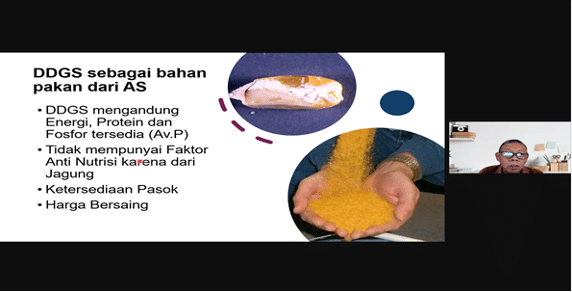The U.S. Grains Council (USGC) remains committed to educating Southeast Asian buyers on the animal health benefits of distiller’s dried grains with solubles (DDGS) and its use as a cost-efficient alternative feed ingredient, despite another wave of COVID-19 in the region.
Dr. Budi Tangendjaja, USGC’s regional technical consultant, conducted a feed formulation series in June and July for Indonesian poultry farmers, covering topics relating to layer farms and the benefits of incorporating DDGS in their feed.
The series began by discussing the technicalities of the feed formulation in West Sumatra and how DDGS can play a role in that. Protein concentrate, local corn and rice bran have traditionally been the main ingredients for layer feed in West Sumatra.
Using Dr. Budi’s revised formula, which consists of less protein concentrate and corn, plus DDGS, palm oil, limestone and lysine, the farmers could save 5-6 percent on feed while maintaining layer performance. One farmer in attendance has since fully adopted Dr. Budi’s formula, lowering costs and improving egg production on his farm.
“DDGS has become a cost-effective alternative feed ingredient in Southeast Asia despite rising freight costs having offset some of the savings from falling freight on board (FOB) prices,” said Chuin Shern Lee, regional marketing manager in USGC’s Southeast Asia office.
More than 20 farmers from Blitar, East Java, were also updated by Dr. Budi on the nutrient’s value and feed prices. Compared to their existing formula, Dr. Budi’s would save farmers there at least 3 percent.
In the final segment of the program, USGC, the U.S. Soybean Export Council (USSEC) and Pt. Gerbang Cahaya worked together to provide the feed ingredient dialogue segment of the series. Representatives of Gerbang Cahaya Utama, one of the largest DDGS importers in Indonesia, shared their knowledge of the U.S. corn co-products they are selling in Indonesia, like DDGS and corn gluten meal (CGM). Dr. Budi reminded participants that it is important for farmers to be flexible in adjusting their feed formulation, reducing costs when necessary.
“It is crucial to keep our Southeast Asian buyers informed on the benefits of adopting DDGS as an alternative feed ingredient and how to use DDGS efficiently to save costs in these challenging times,” Lee said.
The series provided the information buyers desired on DDGS, while also creating new opportunities for farmers and their feed formulations across Southeast Asia.
Read more about USGC’s presence in Southeast Asia.
About The U.S. Grains Council
The U.S. Grains Council develops export markets for U.S. barley, corn, sorghum and related products including distiller’s dried grains with solubles (DDGS) and ethanol. With full-time presence in 28 locations, the Council operates programs in more than 50 countries and the European Union. The Council believes exports are vital to global economic development and to U.S. agriculture’s profitability. Detailed information about the Council and its programs is online at www.grains.org.

